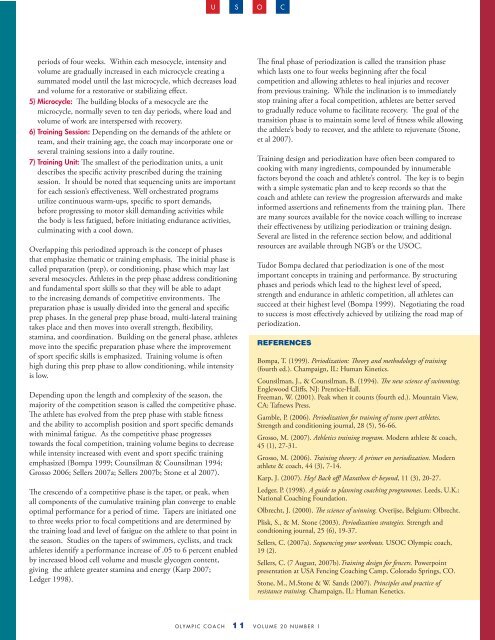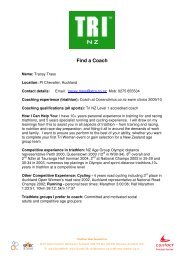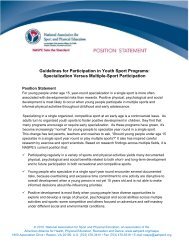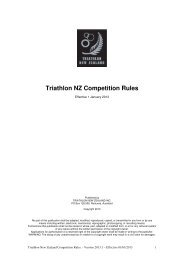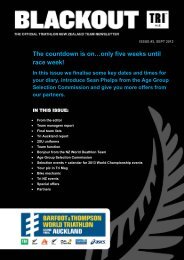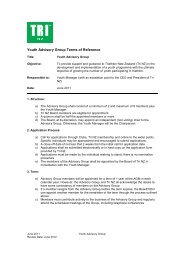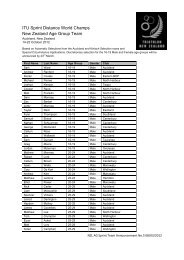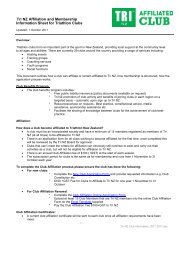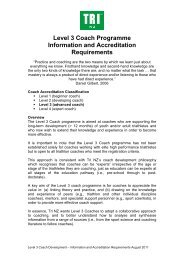Cycling Your Periodization - United States Olympic Committee
Cycling Your Periodization - United States Olympic Committee
Cycling Your Periodization - United States Olympic Committee
You also want an ePaper? Increase the reach of your titles
YUMPU automatically turns print PDFs into web optimized ePapers that Google loves.
U S O Cperiods of four weeks. Within each mesocycle, intensity andvolume are gradually increased in each microcycle creating asummated model until the last microcycle, which decreases loadand volume for a restorative or stabilizing effect.5) Microcycle: The building blocks of a mesocycle are themicrocycle, normally seven to ten day periods, where load andvolume of work are interspersed with recovery.6) Training Session: Depending on the demands of the athlete orteam, and their training age, the coach may incorporate one orseveral training sessions into a daily routine.7) Training Unit: The smallest of the periodization units, a unitdescribes the specific activity prescribed during the trainingsession. It should be noted that sequencing units are importantfor each session’s effectiveness. Well orchestrated programsutilize continuous warm-ups, specific to sport demands,before progressing to motor skill demanding activities whilethe body is less fatigued, before initiating endurance activities,culminating with a cool down.Overlapping this periodized approach is the concept of phasesthat emphasize thematic or training emphasis. The initial phase iscalled preparation (prep), or conditioning, phase which may lastseveral mesocycles. Athletes in the prep phase address conditioningand fundamental sport skills so that they will be able to adaptto the increasing demands of competitive environments. Thepreparation phase is usually divided into the general and specificprep phases. In the general prep phase broad, multi-lateral trainingtakes place and then moves into overall strength, flexibility,stamina, and coordination. Building on the general phase, athletesmove into the specific preparation phase where the improvementof sport specific skills is emphasized. Training volume is oftenhigh during this prep phase to allow conditioning, while intensityis low.Depending upon the length and complexity of the season, themajority of the competition season is called the competitive phase.The athlete has evolved from the prep phase with stable fitnessand the ability to accomplish position and sport specific demandswith minimal fatigue. As the competitive phase progressestowards the focal competition, training volume begins to decreasewhile intensity increased with event and sport specific trainingemphasized (Bompa 1999; Counsilman & Counsilman 1994;Grosso 2006; Sellers 2007a; Sellers 2007b; Stone et al 2007).The crescendo of a competitive phase is the taper, or peak, whenall components of the cumulative training plan converge to enableoptimal performance for a period of time. Tapers are initiated oneto three weeks prior to focal competitions and are determined bythe training load and level of fatigue on the athlete to that point inthe season. Studies on the tapers of swimmers, cyclists, and trackathletes identify a performance increase of .05 to 6 percent enabledby increased blood cell volume and muscle glycogen content,giving the athlete greater stamina and energy (Karp 2007;Ledger 1998).The final phase of periodization is called the transition phasewhich lasts one to four weeks beginning after the focalcompetition and allowing athletes to heal injuries and recoverfrom previous training. While the inclination is to immediatelystop training after a focal competition, athletes are better servedto gradually reduce volume to facilitate recovery. The goal of thetransition phase is to maintain some level of fitness while allowingthe athlete’s body to recover, and the athlete to rejuvenate (Stone,et al 2007).Training design and periodization have often been compared tocooking with many ingredients, compounded by innumerablefactors beyond the coach and athlete’s control. The key is to beginwith a simple systematic plan and to keep records so that thecoach and athlete can review the progression afterwards and makeinformed assertions and refinements from the training plan. Thereare many sources available for the novice coach willing to increasetheir effectiveness by utilizing periodization or training design.Several are listed in the reference section below, and additionalresources are available through NGB’s or the USOC.Tudor Bompa declared that periodization is one of the mostimportant concepts in training and performance. By structuringphases and periods which lead to the highest level of speed,strength and endurance in athletic competition, all athletes cansucceed at their highest level (Bompa 1999). Negotiating the roadto success is most effectively achieved by utilizing the road map ofperiodization.ReferencesBompa, T. (1999). <strong>Periodization</strong>: Theory and methodology of training(fourth ed.). Champaign, IL: Human Kinetics.Counsilman, J., & Counsilman, B. (1994). The new science of swimming.Englewood Cliffs, NJ: Prentice-Hall.Freeman, W. (2001). Peak when it counts (fourth ed.). Mountain View,CA: Tafnews Press.Gamble, P. (2006). <strong>Periodization</strong> for training of team sport athletes.Strength and conditioning journal, 28 (5), 56-66.Grosso, M. (2007). Athletics training trogram. Modern athlete & coach,45 (1), 27-31.Grosso, M. (2006). Training theory: A primer on periodization. Modernathlete & coach, 44 (3), 7-14.Karp, J. (2007). Hey! Back off! Marathon & beyond, 11 (3), 20-27.Ledger, P. (1998). A guide to planning coaching programmes. Leeds, U.K.:National Coaching Foundation.Olbrecht, J. (2000). The science of winning. Overijse, Belgium: Olbrecht.Plisk, S., & M. Stone (2003). <strong>Periodization</strong> strategies. Strength andcondtioning journal, 25 (6), 19-37.Sellers, C. (2007a). Sequencing your workouts. USOC <strong>Olympic</strong> coach,19 (2).Sellers, C. (7 August, 2007b).Training design for fencers. Powerpointpresentation at USA Fencing Coaching Camp, Colorado Springs, CO.Stone, M., M.Stone & W. Sands (2007). Principles and practice ofresistance training. Champaign, IL: Human Kenetics.O L Y M P I C C O A C H 1 1 V O L U M E 2 0 N U M B E R 1


